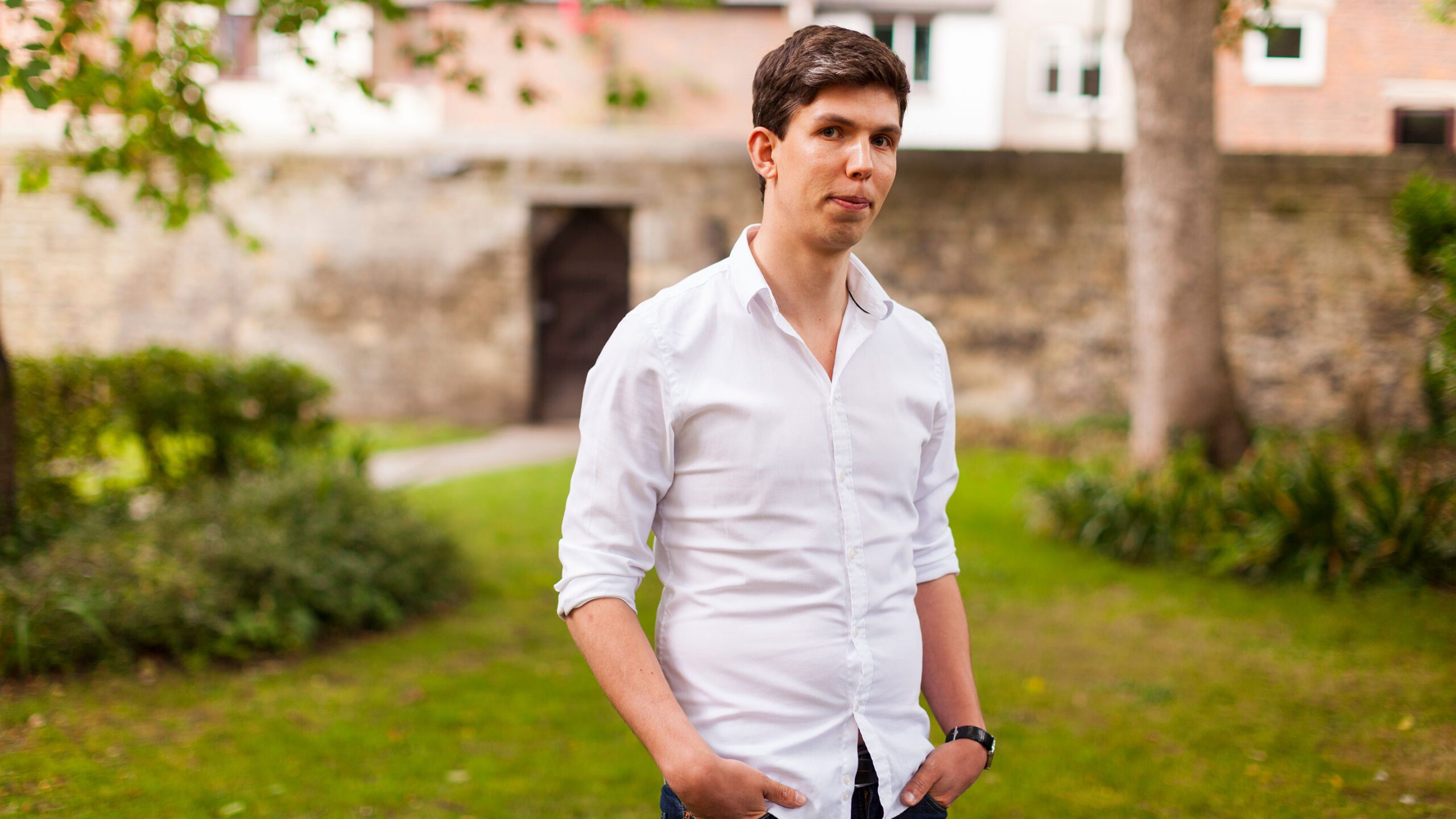
James Maynard outside his home in Oxford, England.
Tom Medwell for Quanta Magazine
Introduction
In 2013, one of the best — but also one of the worst — things that can happen to a mathematician happened to James Maynard. Fresh out of graduate school, he solved one of the discipline’s oldest and most central problems, about the spacing of prime numbers. It was an achievement that ordinarily would have garnered him fame even beyond the cloistered world of pure math research. There was just one difficulty: Another mathematician had proved the most headline-grabbing part of Maynard’s result a few months earlier, using a completely different method.
Number theorists, however, instantly recognized Maynard as someone to watch. Few brand-new Ph.D.s would have been stouthearted enough to even tackle such a problem, let alone solve it. In the years that followed, Maynard more than justified those early hopes, knocking down one fundamental problem after another.
Today, the 35-year-old mathematician, now a professor at the University of Oxford, was awarded the Fields Medal for his “spectacular contributions in analytic number theory,” according to the award citation. “His work is highly ingenious, often leading to surprising breakthroughs on important problems that seemed to be inaccessible by current techniques.”
Maynard, who was informed of his Fields Medal in January, “wasn’t expecting it at all,” he said. “I still fundamentally think of myself as someone who’s slightly finding their feet in the world of mathematics.” He has often drawn inspiration from the work of previous Fields medalists, he said. “Suddenly to be tossed up on this list, with these legends of mathematics who inspired me as [a child], is incredible but completely surreal.”
Fields Medals shine a spotlight that usually follows a mathematician for the rest of their career, but Maynard cherishes the hope that his research life won’t change too much. “I’m still going to be working on the same problems, and interested in the same things,” he said.
Lately, that work has taken the form of a three–paper series about how prime numbers are distributed on the number line. Apart from the numbers 2 and 5, all primes end in 1, 3, 7 or 9, so you could imagine labeling four buckets with those digits and then dropping each prime into its associated bucket as you walk down the number line. Mathematicians have long known that the buckets will all eventually end up with roughly the same number of primes, and this is true not just in base 10 but in any base. What mathematicians don’t know, however, is how quickly the buckets start evening out, a question with implications for many other core questions about prime spacing.
For many bases, Maynard has now shown that the buckets even out faster than a famous speed barrier on which mathematicians were previously stuck. The papers are “really impressive technical achievements,” said Kannan Soundararajan of Stanford University, who will deliver the laudatory lecture on Maynard’s work at the award ceremony in Helsinki today.
For many mathematicians, winning a Fields Medal represents one of the crowning moments of their life. For Maynard, though, the prize has competition even for “most important event of the week.” He and his partner, Eleanor Grant, are expecting the birth of their first child within a few days, allowing Maynard just enough time for a quick visit to Helsinki.
“A lot of things are changing,” he said.
The following profile originally ran in Quanta on July 1, 2020.
Simply Hard Questions
When James Maynard was three, a health visitor came to his home in Chelmsford, just northeast of London, to check on his development. Such visits were routine for young children, and the assessor led him through a standard battery of tests. There was just one problem: Maynard thought they were stupid.
So when she gave him a shape-sorting task, he intentionally put the shapes in a surprising order, then explained at length why his solution was more interesting than hers. And when she asked him what kind of animal the cow in his toy farm was, “he really enjoyed telling her that it was ‘sheep-sheep’ and watching her reaction,” wrote his mother, Gill Maynard, in an email. When he decided the assessment had gone on long enough, he declared it finished and pulled out his Legos.

Maynard uses probabilistic ideas in his number theory research.
Tom Medwell for Quanta Magazine
“It was pretty memorable — a three-year-old demolishing this poor woman,” Gill Maynard said in an interview.
The assessor told his mother that James lacked discipline. “He’ll have real problems in school if he goes on like this,” she said.
Similar episodes cropped up throughout Maynard’s school years. There was the time when his physics teacher used a grading rubric Maynard thought was ridiculous: Correct answers without explanations or units earned only a third of the points. In protest, Maynard wrote the answers only, got them all correct, and scored 33%. “I think the teacher was probably pretty fed up with me,” he said.
“I was definitely one of those annoying kids who would say ‘Why? Why? Why?’ all the time,” Maynard said. He went through his school years “wanting to do my own thing, or at least wanting justifications for things.”
So perhaps it’s not surprising that in 2013, as a newly minted Ph.D., the 26-year-old Maynard simply shrugged when his postdoctoral adviser warned him off the problem he wanted to pursue, one of the most central questions about prime numbers (those whole numbers divisible only by 1 and themselves).
“I kind of said to him, ‘I hope you won’t work on this full time, because I’m really pretty confident you’re going to fail,’” recalled Andrew Granville, Maynard’s mentor at the University of Montreal at the time.
But Maynard “still had the courage,” said Dimitris Koukoulopoulos of the University of Montreal, “and just sat down and said, ‘OK, let me try this idea and see where it takes me.’”
Where it took him was a theorem that “prompted a major reevaluation” of how mathematicians think about the spacing between prime numbers, said Ben Green of the University of Oxford.
Maynard is drawn to questions about prime numbers that are simple enough to explain to a high school student but hard enough to stump mathematicians for centuries. “There’s something very, very appealing to me about the contrast between being simple and fundamental, [and] still being just completely mysterious,” he said.
There’s an abundance of such questions, but fewer now than before Maynard appeared on the scene. For his early success was not a flash in the pan, but the first in a series of discoveries about prime numbers and related structures. Now Maynard is considered one of the world’s leading number theorists.
He has had a “very steep upward trajectory in becoming a world-respected mathematician,” Green said.
Granville, who is writing a book on analytic number theory, complained that Maynard has greatly slowed his progress. “I’ve had to add about 150 extra pages because of him,” Granville said.
Small Signals
I sat down with Maynard in January 2020 at the Joint Mathematics Meetings in Denver, where he had come to receive the Frank Nelson Cole Prize in Number Theory. While this prize is officially awarded for a single notable paper, in Maynard’s case the prize committee couldn’t resist citing three papers, all of which appeared in top mathematics journals.
He had allocated only a day and a half for his Denver trip, but although we met just an hour after he’d arrived from the U.K., there was a spring in his step. “I’m still going on adrenaline,” he said, with a grin that broadened his narrow, boyish face. “The jetlag hasn’t hit me yet.” He smiled readily during our conversation, except when he had to pose for a snapshot. “People say I’m somehow unable to produce a suitable smile in photos,” he said, with a toothy grimace.
Time permitting, Maynard planned to wander the city taking photographs. He took up photography a few years ago to feel more connected to the many cities he visits for work, but it has turned into an obsession. “I went to Hong Kong in the summer and I was hiking out to take pictures with a tripod at dawn,” he said, even though normally he’s anything but a morning person.
Maynard has always had this obsessive streak, and as a child he passed through distinct dinosaur, geology and astronomy phases. “I’m very bad at being moderately interested in things,” he said. “I somehow have to be obsessive about it or I drop it entirely.”
Once Maynard becomes interested in a subject, he tends not to stop until he has reached the limit of his abilities, said his father, Chris Maynard. “But he’s not reached that point in mathematics yet. I think that’s, in a sense, what drives him.”
Even though everyone else in Maynard’s family was oriented toward the humanities — his parents are language teachers and his brother studied history — he always found himself on the path that offered the most mathematics. “At each stage, it just felt like the obvious next step, given how I was feeling at the time,” he said.
In graduate school at Oxford, his extraordinary mathematical strength became apparent. By the second half of his doctoral studies, said his adviser, Roger Heath-Brown, their meetings felt more like collaborations than a mentorship. “I’ve never had that feeling with a research student before,” he said.
By the time Maynard left Oxford for a one-year postdoctoral fellowship at the University of Montreal, he had started mulling over a potential approach to understanding the gaps between prime numbers. As a rule, primes get scarcer as you go out along the number line. But in some ways they also behave like a collection of random numbers, so mathematicians expect them to often be spaced much closer or farther than average. One of the most famous questions in mathematics is the twin primes conjecture, which posits that there are infinitely many pairs of primes that differ by only 2, like 11 and 13.
Maynard suspected that it might be possible to make progress on understanding prime gaps using a method for filtering primes described in a paper from about a decade earlier. While mathematicians had already studied the method closely, Maynard thought it should be possible to extract still more juice from it. “I kept doing calculations and computations, and I kept on getting these sort of small signals that there was something there to be understood and discovered,” he said. “I somehow got completely obsessed by it, and I really wanted to keep on going until I could come up with a way of explaining what I’d seen.”
Granville, his postdoctoral adviser, discouraged Maynard from pursuing this path. “I didn’t really entirely believe it could possibly work, what he was doing,” Granville said. But “James was never really put off by me being very skeptical, in fact — he just laughed at it.”
Early in Maynard’s explorations, a seismic event occurred in the number theory world. An obscure mathematician named Yitang Zhang proved, not quite the twin primes conjecture, but the next best thing: He showed that there are infinitely many pairs of primes that are at most a bounded distance apart (70 million, to be precise). The finding won Zhang instant glory, in the form of multiple job offers (including one from the University of California, Santa Barbara, where he is now on the faculty), invited lectures, news stories and even a documentary.
Meanwhile, Maynard kept working on his own approach to understanding prime gaps, and about six months later, in a flash of insight, he came up with a completely independent, more powerful approach than Zhang’s — it established that there are infinitely many pairs of primes that differ by at most 600. And Maynard’s approach applied not just to pairs of primes, but to triples, quadruples and bigger collections (with different bounds for each). “The result seemed kind of amazing and too good to be true,” said Soundararajan.
And indeed, when Maynard first figured it out, his euphoria was quickly followed by a wave of fear that he had missed some obvious error. Fortunately, he said, “I feel like I work much more productively when suddenly I get terrified that my result is wrong. … Nothing motivates me quite as much as fear.”
Granville insisted that Maynard nail down every detail as he wrote up his result. “Nobody’s going to believe you, because nobody’s ever heard of you,” he told Maynard. “You have to write this so well that nobody can argue with you.”
The end result, Soundararajan said, was an “absolutely fantastic” proof.
Near the end of the process, something happened that might easily strike terror into the heart of a young mathematician: Maynard and Granville learned privately that another mathematician had come up with essentially the same result, in the same time frame. And not just any mathematician, but one of the most prolific and highly regarded mathematicians of the modern era — Fields medalist Terence Tao, of the University of California, Los Angeles. The problem had caught Tao’s eye when he and other mathematicians formed a massive collaboration to reduce the 70-million bound in Zhang’s proof.
Tao had been feeling quite proud of his new result when he learned that a little-known 26-year-old had proved the same thing. “And to be honest, the way he wrote it up, he actually had a cleaner result than I did,” Tao said. “He proved slightly stronger statements.” Tao generously refrained from announcing his own work to avoid overshadowing the achievement of such a young mathematician, knowing that if he and Maynard wrote a joint paper, many mathematicians would assume that Tao had done the lion’s share of the creative work.
It’s easy to imagine an alternative timeline in which Zhang proved his result six months after Maynard instead of six months before (in which case Tao’s explorations would presumably have been delayed or simply forestalled). All the glory would then have accrued to Maynard instead of Zhang. But Maynard doesn’t feel envy at how things played out. “When Zhang proved his result, I was just completely excited,” he said. “The main joy I get is from solving the problem. And so I really didn’t think too much at all about, ‘Oh, if only I had done this slightly differently.’”
A Prime Game
Maynard often chooses to stroll from home to office without wearing his glasses. The gentle blurring helps him focus on mathematics, but it has sometimes led him to walk right past Grant without recognizing her. “And there was one time when he thought he saw me and was really, really proud that he’d seen me, and kind of ran up to this person who didn’t look anything like me,” said Grant, a doctor in Oxford.
Maynard conforms to the stereotype of the absent-minded professor in this and a handful of other ways. For instance, he nearly always wears the same style of clothing, an open-collared white shirt and jeans. “I’m obviously not the most fashion-orientated person,” he wrote in an email. (Once, as a prank, all the mathematicians attending one of his talks showed up wearing the Maynard uniform.)
But he also belies many of the clichés about introverted mathematicians. Colleagues call him warm, fun-loving and outgoing. Pre-pandemic, he brought his own coffee beans to work and brewed coffee for the other number theorists every day after lunch. And when he spent a semester at the Mathematical Sciences Research Institute in Berkeley a few years ago, the house he shared with two other young mathematicians was the “party house,” Heath-Brown said (though Maynard qualified that to “a party house by mathematician standards”).

Tom Medwell for Quanta Magazine
Many of the new generation of number theorists are more social because of Maynard, Granville said. “He’s kind of the center of the group.”
After Maynard proved his theorem about small gaps between primes, number theorists hastened to apply his insights to other problems. But the biggest success in doing so, to date, has come from Maynard himself, who figured out how to address large prime gaps as well, improving upon estimates that had previously seen no significant progress in more than 75 years. Maynard’s adaptation of his method to this new scenario “was one of the cleverest tricks I’ve ever seen in number theory,” Granville said.
“I would say that anybody would be happy to have proved two theorems of this type over the course of their career,” Soundararajan said of Maynard’s results on small and large prime gaps. “The fact that he did it after he’d just finished grad school is quite remarkable.”
In a disconcerting echo of the small-gaps story, Tao once again came up with roughly the same result at roughly the same time (though on this occasion he collaborated with Green and two other co-authors). Since then, Maynard and Tao’s tendency to come up with similar results has become a running joke in the number theory community. When Tao solved another long-standing number theory problem a year or two later, “I remember being very paranoid,” he said, “and just asking Andrew [Granville], ‘I really hope James hasn’t scooped me again this time.’”
Since then, Maynard has given the number theory community ample proof that he is more than just a clone of one of the most famous mathematicians in the world. In 2019, for instance, he and Koukoulopoulos settled a nearly 80-year-old question called the Duffin-Schaeffer conjecture that asks which infinite collections of denominators produce fractions that do a good job of approximating irrational numbers. “It’s just been the holy grail in a certain area of … approximation for a long time,” Granville said.
And a few years ago, Maynard tackled perhaps the ultimate easy-to-state but hard-to-prove question about prime numbers, proving that there are infinitely many primes that don’t have any 7s (or any other digit you might choose). While numbers without any 7s are plentiful if you’re looking at small numbers, they are almost vanishingly rare when you start looking at, say, 1,000-digit numbers, so showing that this sparse number set contains infinitely many primes is no simple matter. “This is something that people have wondered about for a long, long time, and no one got anywhere close to proving,” Heath-Brown said.
This question makes sense in other bases besides 10, and Maynard started by coming up with a proof for very large bases. The bigger the base, the easier it is to prove a theorem of this sort, since if you’re in a base with, say, a million different numerals instead of just 0 to 9, a restriction like “no 7s” has a smaller impact. Maynard’s proof for large bases was “very elegant,” Granville said.
But Maynard became obsessed with proving his theorem in ordinary base 10. “Base 10 is somewhat arbitrary from a mathematical point of view, but … it’s the base that everyone talks about normally in daily life,” he said.
Starting with base 1,000,000, he kept reducing the base, first to 5,000, then 1,000, then 100. “It became almost a game with myself about how sophisticated an argument could I come up with,” he said. “It was almost like these betting machines or these games online that give you a little endorphin hit each time.”
He got stuck on base 12 for a long time — long enough to worry that the final goal would elude him. But eventually he made it to base 10. “I was very happy to just about drag myself over the line and then declare victory,” he said.
Maynard had to invent all kinds of new ideas to get to base 10. “This shows his utter, extraordinary, powerful strength as a mathematician,” Granville said.
This contribution and the rest have created a buzz of energy and anticipation among number theorists. “I’m not sure there’s anyone else in analytic number theory at the moment that I would think is generating more excitement,” Heath-Brown said.
“People are wondering, ‘What’s he going to do next?’” he said. “Everything seems possible.”




